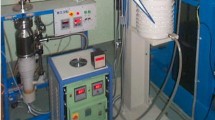Abstract
A customized-built high-temperature tensile creep setup is introduced. Dog-bone shaped miniaturized specimens made from Nimonic-75 were tested as reference materials at temperatures of 850 and 1000 °C under constant load to verify the setup’s accuracy. The results were compared to tensile creep tests with conventional (standard size) specimens at identical experimental conditions. The shape of the creep curves obtained in the miniaturized specimens exhibits a pronounced minimum creep rate, thus, being seemingly different from the ones obtained for the bulk samples which reveal a clear steady-state regime. This is partly due to the continuous increase of stress under constant load testing conditions and very likely affected by the much higher surface to volume ratio of the miniaturized specimens leading to the premature onset of tertiary creep. Still, a good agreement was obtained between the two specimen sizes with respect to the dependence of the steady-state (standard size) and minimum (miniaturized size) strain rate on applied stress at various temperatures leading to also comparable activation energies of the creep.







Similar content being viewed by others
References
D.S. Gianola and C. Eberl: Micro-and nanoscale tensile testing of materials. JOM 61 (3), 24 (2009).
K.J. Hemker and W.N. Sharpe: Microscale characterization of mechanical properties. Annu. Rev. Mater. Res. 37 (1), 93 (2007).
M. Zupan, M.J. Hayden, C.J. Boehlert, and K.J. Hemker: Development of high-temperature microsample testing. Exp. Mech. 41 (3), 242 (2001).
N.J. Karanjgaokar, C-S. Oh, and I. Chasiotis: Microscale experiments at elevated temperatures evaluated with digital image correlation. Exp. Mech. 51 (4), 609 (2011).
D. Peter, F. Otto, T. Depka, P. Nörtershäuser, and G. Eggeler: High temperature test rig for inert atmosphere miniature specimen creep testing. Materialwiss. Werkstofftech. 42 (6), 493 (2011).
G. Mälzer, R.W. Hayes, T. Mack, and G. Eggeler: Miniature specimen assessment of creep of the single-crystal superalloy LEK 94 in the 1000 °C temperature range. Metall. Mater. Trans. A 38 (2), 314 (2007).
D. Leisen, R. Rusanov, F. Rohlfing, T. Fuchs, C. Eberl, H. Riesch-Oppermann, and O. Kraft: Mechanical characterization between room temperature and 1000 °C of SiC free-standing thin films by a novel high-temperature micro-tensile setup. Rev. Sci. Instrum. 86 (5), 055104 (2015).
B.V. Grossmann, H. Biermann, and H. Mughrabi: Measurement of service-induced internal elastic strains in a single-crystal nickel-based turbine blade with convergent-beam electron diffraction. Philos. Mag. A 80 (8), 1743 (2000).
J. Albiez, I. Sprenger, C. Seemüller, D. Weygand, M. Heilmaier, and T. Böhlke: Physically motivated model for creep of directionally solidified eutectics evaluated for the intermetallic NiAl–9Mo. Acta Mater. 110, 377 (2016).
M. Heilmaier: Modellkompatible Beschreibung des Kriech-und Zeitstandverhaltens oxiddispersionsgehärteter Nickelbasissuperlegierungen (model-based description of the creep deformation and fracture behavior of oxide-dispersion strengthened nickel-base superalloys). Ph.D. thesis, VDI-Verlag, Düsseldorf, 1993.
M. Heilmaier and B. Reppich: Creep lifetime prediction of oxide-dispersion-strengthened nickel-base superalloys: A micromechanically based approach. Metall. Mater. Trans. A 27 (12), 3861 (1996).
M. Nganbe and M. Heilmaier: High temperature strength and failure of the Ni-base superalloy PM 3030. Int. J. Plast. 25, 822 (2009).
C. Eberl, R. Thompson, D.S. Gianola, and S. Bundschuh: Digital image correlation and tracking (Matlab Central File ID:12413, The Mathworks, Inc., Natick, MA, 2006).
C. Eberl, D.S. Gianola, and K.J. Hemker: Mechanical characterization of coatings using microbeam bending and digital image correlation techniques. Exp. Mech. 50 (1), 85 (2010).
T.C. Chu, W.F. Ranson, M.A. Sutton, and W.H. Peter: Applications of digital-image-correlation techniques to experimental mechanics. Exp. Mech. 25 (3), 232 (1985).
D. Lecompte, A. Smits, S. Bossuyt, H. Sol, J. Vantomme, D. Van Hemelrijck, and A.M. Habraken: Quality assessment of speckle patterns for digital image correlation. Opt. Lasers Eng. 44 (11), 1132 (2006).
B. Pan, H. Xie, Z. Wang, K. Qian, and Z. Wang: Study on subset size selection in digital image correlation for speckle patterns. Opt. Express 16 (10), 7037 (2008).
M.A. Sutton, J.H. Yan, V. Tiwari, H.W. Schreier, and J.J. Orteu: The effect of out-of-plane motion on 2D and 3D digital image correlation measurements. Opt. Lasers Eng. 46 (10), 746 (2008).
H.J. Frost and M.F. Ashby: Deformation Mechanism Maps (Pergamon Press, Oxford, 1982).
F. Krieg, M. Mosbacher, M. Fried, E. Affeldt, and U. Glatzel: Creep and oxidation behaviour of coated and uncoated thin walled single crystal samples of the alloy PWA1484. In Superalloys 2016: Proc. 13th Inter. Symp. Superalloys, M. Hardy, E. Huron, U. Glatzel, B. Griffin, B. Lewis, C. Rae, V. Seetharaman, and S. Tin, eds. (Wiley-TMS, Hoboken, New Jersey, 2016); p. 773.
M. Bensch, E. Fleischmann, C.H. Konrad, M. Fried, C.M.F. Rae, and U. Glatzel: Secondary creep of thin-walled specimens affected by oxidation. In Superalloys 2012: Proc. 12th Inter. Symp. Superalloys, E.S. Huron, R.C. Reed, M.C. Hardy, M.J. Mills, R.E. Montero, P.D. Portella, and J. Telesman, eds. (Wiley-TMS, Hoboken, New Jersey, 2012); p. 387.
T.B. Gibbons: Creep properties of Nimonic 90 in thin section. Met. Technol. 8 (1), 472 (1981).
V. Seetharaman and A.D. Cetel: Thickness debit in creep properties of PWA 1484. In Superalloys 2004: Proc. 10th Inter. Symp. Superalloys, K.A. Green, T.M. Pollock, and H. Harada, eds. (Wiley-TMS, Warrendale, Pennsylvania, 2004); p. 207.
Z.X. Wen, H.Q. Pei, D.F. Li, Z.F. Yue, and J.Y. Gao: Thickness influence on the creep response of DD6 Ni-based single-crystal superalloy. High Temp. Mater. Processes 35 (9), 871 (2016).
ACKNOWLEDGMENTS
This research was financially supported by the Helmholtz Association of German Research Centers under the framework of the Helmholtz Research School on “Integrated Materials Development for Novel High Temperature Alloys”, Grant No. VH-KO-610.
Author information
Authors and Affiliations
Corresponding author
Rights and permissions
About this article
Cite this article
Luan, L., Riesch-Oppermann, H. & Heilmaier, M. Tensile creep of miniaturized specimens. Journal of Materials Research 32, 4563–4572 (2017). https://doi.org/10.1557/jmr.2017.414
Received:
Accepted:
Published:
Issue Date:
DOI: https://doi.org/10.1557/jmr.2017.414




